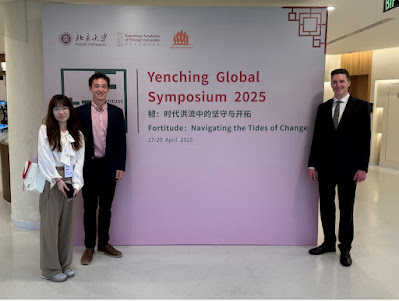Hefei and NIO's Symbiotic Relationship
Ever wonder if you can tour an electric vehicle factory in China? Three HNC students did their research and recently took a road trip to visit a NIO factory in neighboring Anhui province. China's EV market is massive and competitive, which makes China a fascinating place to experience this aspect of the green energy transition.
Chris (right) and two classmates at the NIO Factory Experience Center |
On an overcast April morning, I arrived in Hefei, the capital city of Anhui province, with two classmates. Our destination was a NIO car factory which produces top-of-the-line electric vehicles. NIO has become famous in China and abroad for its unique battery-swapping, rather than charging, technology. NIO owners can pull into any of the nearly 2,500 battery swapping stations to receive a new battery pack and be on their way. This automated process lifts the car, removes the depleted battery, stores it in an underground vault, and replaces it with a fully charged battery. The whole process takes about 3 minutes.
The tour of the factory lasted less than an hour and brought us into the belly of their production line where car parts whiz along conveyor belts at different stages of assembly. By far the most impressive part of the tour was seeing the level of automation. This NIO factory has integrated nearly 900 fully automated robots into the assembly line. One particularly striking scene was watching four robotic arms attach car doors to the body of the car. The intricacy and precision were mesmerizing, we watched the 96-second process five times before our tour guide finally told us we had to move on.
NIO is one of the many domestically manufactured EV brands that is propelling China to a dominant position in the market both in terms of production and consumption. During the first quarter of 2024, NIO sold just over 30,000 cars, putting it ahead of basically every brand that isn’t Chinese or Tesla over the same period. NIO is distinct from other Chinese brands like BYD because they cater to the luxury market. Prices range from just under RMB 30,000 (USD 41,000) to over RMB 55,000 (USD 76,000) for their top-line models. NIO is also unique because of how bullish they have been on their ability to sell their cars internationally. The company has successfully launched four models in the EU and NIO has pledged to enter the North American market by 2025, though it seems unlikely that they will be able to make good on that goal.
Amid all of this excitement, it’s easy to forget just how young this company is. NIO was founded in 2014, and its meteoric rise over the 10 years since then can be largely attributed to the very successful relationship with the city of Hefei.
Over the last decade, Hefei has experienced rapid economic development and is swiftly becoming a national success story for public-private cooperation in incubating high-tech industries. Between 2010 and 2020, Hefei was China’s fastest-growing city in terms of GDP and as of 2024, so-called “strategic emerging industries” like EVs accounted for 56% of total industrial output, up from 27% in 2013. More shocking stats: since 2019, Hefei’s car production has tripled and today, Hefei manufactures more cars than Michigan.
The story of Hefei and NIO began in earnest in 2020 when the city government of Hefei––via a complex network of state-owned enterprises and other private-public lending agencies––provided 7 billion RMB (1 billion USD) in investments. According to Bloomberg, the funds came as NIO faced serious liquidity issues. A statement released by NIO following the investment indicates that the investors would own roughly 25% of the company, while NIO China would retain control of the remaining 75%.
What followed would become the so-called “Hefei model” for public-private partnerships in strategic industries. SCMP reported that following the investment, NIO relocated its executives from Shanghai to Hefei, and in 2021, the company began to turn a profit, selling more than 90,000 cars by the end of the year. To put it succinctly, the symbiotic relationship between Hefei and NIO has been a huge success, making Hefei a national success story that other local governments seek to emulate.
Both inside and outside of China, much ink has been spilled trying to clearly articulate what exactly makes the Hefei model work. In broad strokes, the city government in Hefei is a cross between a central planner and a venture capitalist. Government financing entities buy shares from start-ups that need cash and provide low-interest loans from banks to finance development.
This financing is bolstered by other forms of support. During our tour of the NIO factory, we drove through the Hefei Xinqiao Science and Technology Innovation Demonstration Zone, a gigantic, modern industrial park. The government provides support for funding development and attracting talent to high-tech manufacturing companies in the park. The Hefei model also owes some of its success to the University of Science and Technology which churns out engineers ready to enter the workforce.
Abroad, the same support systems that have made NIO successful might leave it vulnerable to trade sanctions. The EU has opened a probe into unfair subsidies in China’s EV sector, and the US is considering an outright ban on Chinese EVs. Domestically, local governments rushing to mimic the Hefei model contribute to domestic overcapacity, earning a rebuke from Xin Guobin, Vice Minister of China’s Ministry of Industry and Information Technology.
One of the problems contributing to overcapacity is an enormously overcrowded EV market; NIO has to contend with more than 200 competing manufacturers for domestic market share. As overcapacity exerts a downward force on prices, that number should start to come down. The question for NIO executives and Hefei politicians is whether or not NIO can weather the storm and emerge poised to occupy a pivotal role in China’s luxury EV market.
Written by Chris Hankin, MAIS '24. Edited by Sam Trizza, Cert+MAIR '25.





